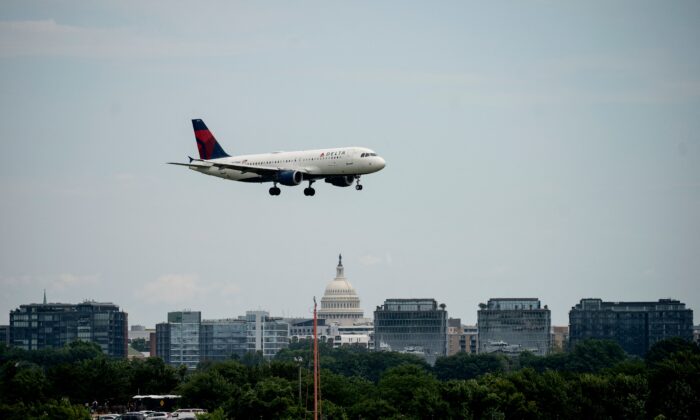Passenger Plane and Military Jet Rerouted to Prevent Collision at Reagan National Airport
Delta Flight 2983 was granted takeoff clearance on March 28 at approximately the same time that four T-38s from the U.S. Air Force were approaching for a flyover of Arlington Cemetery.
A passenger aircraft and an Air Force jet had to adjust their paths to prevent a potential mid-air collision near the Ronald Reagan Washington National Airport, located just outside Washington, D.C.
Delta Air Lines Flight 2983 received takeoff clearance at around 3:15 p.m. on March 28. Meanwhile, four U.S. Air Force T-38 Talon jets were headed for a ceremonial flyover at Arlington Cemetery, according to a statement released by the Federal Aviation Administration.
As one of the Air Force jets neared the Delta aircraft, air traffic controllers instructed both to alter their courses to avert a collision.
A recording of the air traffic control communications indicated that the Air Force jet was just 500 feet below the Delta plane once both aircraft successfully changed their paths.
The Airbus A319 was carrying 131 passengers, along with two pilots and three flight attendants, on its scheduled flight from Reagan to Minneapolis-St. Paul International Airport, as per Delta Airlines.
The incident in January prompted questions regarding the military’s failure to implement a crucial safety measure known as ADS-B on helicopter training flights.
It also highlighted Congressional attempts to establish more direct flights to meet lawmakers’ schedules, despite ongoing safety alerts from local airport officials regarding the airport’s limited capacity.
A total of 64 additional daily flights have been introduced at Reagan since 2000, with 10 more expected from last year’s legislation. This escalation has resulted in Reagan hosting the busiest runway in the country while being the 24th busiest airport in terms of aggregate flights.
The congested airspace surrounding Washington gained attention last year when Congress discussed an aviation safety bill permitting an additional 10 flights daily at Reagan, which attracted strong resistance from lawmakers in Virginia where the airport is situated.
The American Airlines flight involved in January’s accident was operating on a newly added route from Wichita, Kansas, and had been redirected to a different runway closer to Army helicopter flight paths due to congestion on its original designated runway.
The safety concerns at the airport have been exacerbated by its proximity to a number of military bases, including Bolling Air Force Base, located directly across the Potomac River from Reagan in Washington, D.C.
The National Transportation Safety Board indicated that airplane pilots entering or departing from Reagan had been alerted to take evasive measures to avoid helicopters at least once per month, every month from 2011 to 2024.
In a similar instance on March 1, more than a dozen flights that were approaching Reagan received false warnings of impending collisions, leading at least six flights to abort their landings. The FAA later clarified that these false alarms were the result of government tests involving counter-drone technology.
In the wake of the January incident, the FAA has instituted permanent limitations on non-essential helicopter operations around Reagan and has prohibited helicopters and passenger jets from flying in close proximity to each other.
The Associated Press and Reuters contributed to this report.




